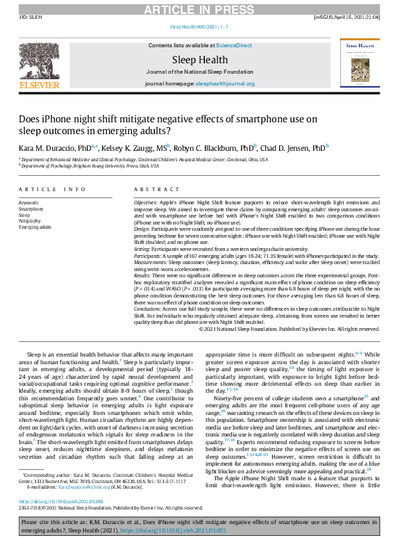 Diese Seite wurde seit 2 Jahren inhaltlich nicht mehr aktualisiert.
Unter Umständen ist sie nicht mehr aktuell.
Diese Seite wurde seit 2 Jahren inhaltlich nicht mehr aktualisiert.
Unter Umständen ist sie nicht mehr aktuell.
 Zusammenfassungen
Zusammenfassungen
Objectives:
Apple's iPhone Night Shift feature purports to reduce short-wavelength light emissions and improve sleep. We aimed to investigate these claims by comparing emerging adults’ sleep outcomes associated with smartphone use before bed with iPhone's Night Shift enabled to two comparison conditions (iPhone use with no Night Shift, no iPhone use).
Design: Participants were randomly assigned to one of three conditions specifying iPhone use during the hour preceding bedtime for seven consecutive nights: iPhone use with Night Shift enabled; iPhone use with Night Shift disabled; and no phone use.
Setting: Participants were recruited from a western undergraduate university.
Participants: A sample of 167 emerging adults (ages 18-24; 71.3% female) with iPhones participated in the study.
Measurements: Sleep outcomes (sleep latency, duration, efficiency and wake after sleep onset) were tracked using wrist-worn accelerometers.
Results: There were no significant differences in sleep outcomes across the three experimental groups. Post-hoc exploratory stratified analyses revealed a significant main effect of phone condition on sleep efficiency (P = .014) and WASO (P = .013) for participants averaging more than 6.8 hours of sleep per night, with the no phone condition demonstrating the best sleep outcomes. For those averaging less than 6.8 hours of sleep, there was no effect of phone condition on sleep outcomes.
Conclusions: Across our full study sample, there were no differences in sleep outcomes attributable to Night Shift. For individuals who regularly obtained adequate sleep, abstaining from screen use resulted in better quality sleep than did phone use with Night Shift enabled.
Von Kara M.Duraccio, Kelsey K.Zaugg, Robyn C.Blackburn, Chad D.Jensen im Text Does iPhone night shift mitigate negative effects of smartphone use onsleep outcomes in emerging adults? (2021) Design: Participants were randomly assigned to one of three conditions specifying iPhone use during the hour preceding bedtime for seven consecutive nights: iPhone use with Night Shift enabled; iPhone use with Night Shift disabled; and no phone use.
Setting: Participants were recruited from a western undergraduate university.
Participants: A sample of 167 emerging adults (ages 18-24; 71.3% female) with iPhones participated in the study.
Measurements: Sleep outcomes (sleep latency, duration, efficiency and wake after sleep onset) were tracked using wrist-worn accelerometers.
Results: There were no significant differences in sleep outcomes across the three experimental groups. Post-hoc exploratory stratified analyses revealed a significant main effect of phone condition on sleep efficiency (P = .014) and WASO (P = .013) for participants averaging more than 6.8 hours of sleep per night, with the no phone condition demonstrating the best sleep outcomes. For those averaging less than 6.8 hours of sleep, there was no effect of phone condition on sleep outcomes.
Conclusions: Across our full study sample, there were no differences in sleep outcomes attributable to Night Shift. For individuals who regularly obtained adequate sleep, abstaining from screen use resulted in better quality sleep than did phone use with Night Shift enabled.
 Dieser wissenschaftliche Zeitschriftenartikel erwähnt ...
Dieser wissenschaftliche Zeitschriftenartikel erwähnt ...
 Anderswo finden
Anderswo finden
 Volltext dieses Dokuments
Volltext dieses Dokuments
 |  Does iPhone night shift mitigate negative effects of smartphone use onsleep outcomes in emerging adults?: Artikel als Volltext ( Does iPhone night shift mitigate negative effects of smartphone use onsleep outcomes in emerging adults?: Artikel als Volltext ( : :  , 552 kByte; , 552 kByte;  : :  ) ) |
 Anderswo suchen
Anderswo suchen 
 Beat und dieser wissenschaftliche Zeitschriftenartikel
Beat und dieser wissenschaftliche Zeitschriftenartikel
Beat hat Dieser wissenschaftliche Zeitschriftenartikel während seiner Zeit am Institut für Medien und Schule (IMS) ins Biblionetz aufgenommen. Beat besitzt kein physisches, aber ein digitales Exemplar. Eine digitale Version ist auf dem Internet verfügbar (s.o.). Aufgrund der wenigen Einträge im Biblionetz scheint er es nicht wirklich gelesen zu haben. Es gibt bisher auch nur wenige Objekte im Biblionetz, die dieses Werk zitieren.











 iPhone
iPhone Melatonin
Melatonin Schlaf
Schlaf
 Biblionetz-History
Biblionetz-History